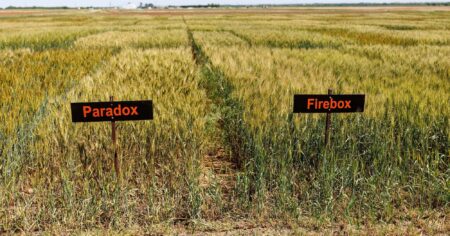Every winter, I really enjoy teaching our Kluis Grain Trading Academy course. I like to show our students all the players in the grain futures market and how they impact open interest. This winter, it was amazing to watch corn open interest increase to a record 2 million-plus contracts. That is 10 billion bushels! I was amazed at the rally in the corn market. I could start to see the bullish potential develop in October 2024, well after the major low in August 2024.
There’s an old rule that says, “When prices are trending higher and open interest is going up, you are in a bull market.” This was proved right again this winter. Another rule about bull markets is that friends and stock market investors start to ask me lots of questions! It seems like everybody trades corn now.
Recently, I had two very different conversations about the corn market. The first was with a farmer at a trade show. He said, “Did you think the corn futures market could rally $1 per bushel in 60 days … right after we harvested a corn crop of almost 15 billion bushels?” After a pause he blurted out, “I sold my corn in late October rather than pay for storage!”
I could tell he was very frustrated. I was honest and said that it was a larger move than I expected and that it came in much earlier than I expected. However, I explained, it has been an orderly uptrend, so far. We went on to talk about his plan for the next year.
The same weekend, I went to a friend’s birthday party. He worked at a large hedge fund, and a lot of his coworkers were there. One young portfolio manager came over to talk about the corn market, one of the markets he traded. “Wow!” he said. “What a run in the corn market! How long till it hits $6?” He got long corn in October, and the way his trading system worked, he automatically doubled up on every 10¢ rally. This is a version of momentum trading that can work great in trending markets.
He was confident without being cocky, and truly wanted to know what I thought. (He knew I had traded in the corn market for longer than he had been alive.) I warned him that his strategy of doubling up could result in a large long position at the top of the corn market. I encouraged him to look at the live cattle daily chart and see what happened in February, when funds got loaded up with a record long position.
I again answered his question honestly that $6 corn was a possibility but not a high probability. The bull market in corn was an old bull market that had been trending higher for seven months, since last August. I told him it would take some pretty extreme weather problems in the U.S. for $6 corn futures, and that probability was less than 20%. I don’t know what he did with that information, but I’m sure he’ll tell me someday.
More Players
These are real-life examples of some participants of the corn market and all the other grain markets. You have always had the corn producers and livestock feeders buying and selling corn futures. Now, you have corn farmers, grain elevators, livestock producers, ethanol plants, retail traders, and hedge funds trading corn futures. The largest growth in the trading volume has come from hedge funds. When I mentioned this at a late-winter seminar, several of the farmers were upset and said they felt the system was stacked against them. I politely disagreed.
I explained that hedge funds can create more short-term volatility but that they are not like commercial grain companies. Every corn futures contract the funds buy, they eventually have to sell back. They create a lot of volume, which allows me to hedge corn futures out for three to four years. This, in turn, allows me to manage risk a lot better for corn farmers.
Do Hedge Funds Have an Advantage?
The reality is that, like it or not, all those players in the grain markets are not going away.
I thought a lot more about the corn farmers and the portfolio manager. I decided to do a deep dive into who is trading the corn market — and why — and what it means for us. Do funds have an advantage? Most important, how can I help farmers do a better job in this new trading environment?
First, let’s look at the “why.” Why would a portfolio manager who has never set foot on a farm be interested in corn? Because corn is a “real product” — not something virtual, like stock ETFs or bitcoin.
Furthermore, as the portfolio manager told me, by many historic measures, corn and soybeans are cheap. An ounce of gold that day would buy 590 bushels of corn and 283 bushels of soybeans. He said, “If I want an inflation hedge, it is less risky to own corn and soybeans than more gold.” I thought to myself, hmm — corn and soybeans seemed really cheap compared with the current price of gold — and corn is real.
Regarding the image at the beginning of this article “How Many Bushels of Corn Can 1 Oz. of Gold Buy?” Prior to 1976, the price of gold was set at $35 per ounce, and the U.S. dollar was backed by gold. When inflation started to heat up, the decision was made to let the price of gold float (trade), and gold prices rallied to $800 per ounce by 1980. When the Fed raised interest rates to 21%, gold prices and inflation slowed into the mid-1980s. For much of the 1990s and into the early 2000s, an ounce of gold would buy 150–250 bushels of corn. As recently as 2020, an ounce of gold would buy 250 bushels of corn. Now, with an ounce of gold buying over 650 bushels, corn seems undervalued and is a better investment than gold.
Next: Do funds have an advantage? Funds do indeed have access to lots of information, and faster computers. Many have access to a lot of capital. But history shows that over the last decade, for every fund that succeeds, many more close. I think that a young farmer today has a better chance of being a farmer 20 years from now than a young portfolio manager does being a portfolio manager 20 years from now. My research again shows some short-term advantage to some funds, but not a long-term advantage.
The Big Question
Then, the big question: How can I help farmers do a better job in this new trading environment?
Here are my top three tips:
1. I can only help those who want to help themselves.
A farmer who wants to stay profitable and be farming 20 years from now needs to learn more about marketing. You have to be willing to attend classes or seminars about the basics of grain marketing and futures trading.
2. You must be disciplined.
Spread out risk by making multiple sales as the markets rally, and stop selling when prices collapse. (In other words, you must do the opposite of the hedge fund momentum traders.)
3. You have to know your cost of production.
If you know you can sell your corn and soybeans ahead at a profit (and also buy puts at the right time), then you may leave some money on the table some years, but you have a high probability of keeping your farm profitable.
I suggest we all adjust our thinking about big hedge fund traders. Because of the way they trade — buying on strength and selling on weakness — they will drive prices up for us, faster and higher. They will also drive prices down, faster and lower.
Bad? No, good — if you use it to your advantage. Take advantage of that volatility. When prices are rocketing up, sell fast and sell often. When prices are tanking, stand back and wait. Or, if you have learned how to use more marketing tools, stand back and watch your puts gain value.
Indeed, we can think of the funds as another crop to harvest. In late February, that worked great for my subscribers in the corn market.
Note: The risk of loss in trading futures and/or options is substantial, and each investor and/or trader must consider whether this is a suitable investment. Past performance — whether actual or indicated by simulated historical tests of strategies — is not indicative of future results. Trading advice reflects good-faith judgment at a specific time and is subject to change without notice. There is no guarantee that the advice given will result in profitable trades.


:max_bytes(150000):strip_icc()/2308-01-097_pigs-b0529b97e3e943d392b7014aee9eb4f5.jpg)

:max_bytes(150000):strip_icc()/DC-5ec71dd349104ec287b318f05ebf5f74.jpg)


:max_bytes(150000):strip_icc()/Screenshot2025-04-16at1.51.09PM-ac4c84213e8b4be2bd5b1b1307846d75.png)
:max_bytes(150000):strip_icc()/SFCE_Sp25_WortheyFarmersMarket_preview1-9c3c0b2c5e9444249fa60594b7f30fec.jpg)
:max_bytes(150000):strip_icc()/TaylorsFireworkssign-c3dd3eb41cc646c593dbebfee850bdc0.jpg)

:max_bytes(150000):strip_icc()/diseaseplaybookcorntarspot-fb7ff9d7c32e4e63b3e5e97dbe406eeb.jpg)